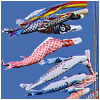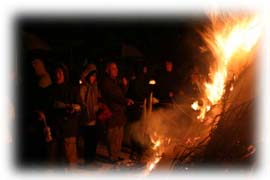日本について学ぶ > 日本の1年 > 年中行事 > Events of the New Year's Period: Matsunouchi and Koshōgatsu

|

年中行事
- 日本の暦
- 六曜
- 松の内と小正月(1月)
- 節分(2月3日)
- バレンタインデー(2月14日)
- ひな祭り(3月3日)
- ホワイトデー(3月14日)
- 花見シーズン(3月-4月)
- 端午の節句(5月5日)
- 母の日(5月の第二日曜日)
- 父の日(6月の第三日曜日)
- 七夕(7月7日)
- 暑中見舞い
- お中元
- お盆
- 七五三(11月15日)
- クリスマス(12月25日)
- お歳暮
|

People burn their New Year's decorations at a donto fire.
Photo Courtesy of Kamoshikaya.
Events of the New Year's Period: Matsunouchi and Koshōgatsu
Even after the first three days of the new year have passed, Japanese observe a series of new year’s events. The new year season, called matsunouchi, continues for the seven days from New Year’s day to the January7th. People eat rice porridge made with seven kinds of vegetables on January 7th to give good health throughout the year. At the end of matsunouchi, New Year’s decorations are taken down, and people prepare to return to their daily lives.
January 15th, which in the old lunar calendar would have been the first full moon of the year, is the “little new year”. Many events, including donto-yaki, when people burn their New Year’s decorations, are held on this day. People bring decorations from home that are made from natural materials, such as kadomatsu (arrangements of bamboo, pine and plum) and shimekazari (wreaths and ropes made of straw and white paper) and pile them up at a local shrine or a public open space. After a Shinto priest offers a chanted prayer, the pile is set on fire. Eating a rice cake grilled on the donto-yaki fire will keep you healthy for the rest of the year.
|
|
|
| ポッドキャスト ダウンロード:
英語
| 日本語
|
|
文書 |
ビデオクリップ |
図表 |
写真 |
地図
|
|

